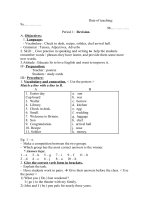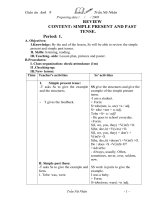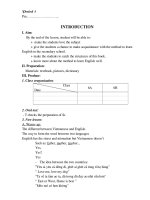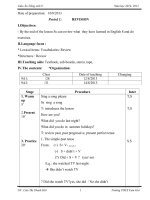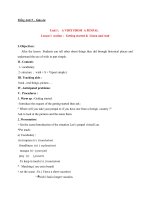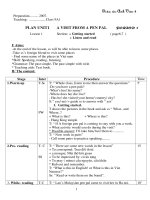giáo án tiếng anh 9 kì 1
Bạn đang xem bản rút gọn của tài liệu. Xem và tải ngay bản đầy đủ của tài liệu tại đây (544.89 KB, 108 trang )
Date of teaching:
9a……………
9b…………….
Period 1: Revision.
A. Objectives:
1. Language:
- Vocabulary : Check in desk, recipe, solider, chef arrival hall.
- Grammar : Tenses, Adjectives, Adverbs
2. Skill : Give practice in speaking and writing to help the students
remember words / phrases they have learnt, and provide them some more
new words.
3.Attitude : Educate Ss to love English and want to improve it.
II> Preparation:
Teacher : posters
Students : study cards
III> Procedure:
1. Vocabulary and connection. < Use the posters >
Match a line with a line in B.
A B
1. Easter day
Cup board
3. Wallet
4. Library.
5. Check in desk.
6. Smell.
7. Welcome to Britain.
8. Son
9. Congratulation.
10. Recipe
11. Soldier
a. sun
b. war
c. borrow
d. kitchen
e. egg
f. wedding
g. luggage
h. chef
i. arrival hall
j. nose
k. money.
Eg: 1 – e.
- Make a competition between the two groups.
- Which group has the most correct answers is the winner.
* Answer keys:
1 – e 3 – k 5 – g 7 – i 9 – f 11 – b
2 – d 4 – c 6 – j 8 – a 10 – h
2. Give the correct verb form in brackets.
- Explain the task.
- Have students work in pairs. Give their answers before the class. < Use
the poster >
1) What you ( Do ) last weekend ?
I ( go ) to the theater with my family.
2) John and I ( be ) pen pals for nearly three years.
3) We used ( write ) to each other very month when we ( be ) at secondary
school.
4) Minh ( know ) a little English so she wishes she could < speak ) it
fluently.
5) Miriam ( stay ) with us at the moment. She ( be ) my sister’s friend.
* Answer key:
1. did you do / went 4. knows / speak.
2. Have been 5. is staying / is
3. to write
3. Adjectives / Adverbs. ? < Use the poster >
* Underline the correct answer.
- Divide the class into 4 groups.
- Sts work in groups and write their answers on the poster.
- Hang on their posters for correction Give their answer key.
E.g: The children are always very happy / happily.
1. Your children played happy / happily.
2. She sings very good / well.
3. How are you ? Very good / well. Thank you.
4. I just want a quick / quickly snack, please.
5. I had breakfast quick / quickly because I was late for work.
6. You are speaking very quiet / quietly. I can’t hear you.
7. He is very slow / slowly readers.
* Answer key:
1. happily. 4. quick. 7. slow.
2. well. 5. quickly.
3. well quietly.
* Notice: - Adjectives are used modify for Nouns.
- Adverbs are used to modify for : - Verbs
- Adjectives
- Adverbs
4. Homework:
- Revise the uses of the passive voice.
- See Unit one in advance.
Date of teaching:
9a……………
9b…………….
Unit one: a visit form a pen pal
Period 2: Getting started + listen & read
A. Objectives:
1. Language:
- Vocabulary: pal, correspond, friendliness, Mosque, peaceful atmosphere,
keep in touch.
- Structures: - be impressed by.
- used to + V.
- S + wish + S + Past simple
2. Skill : Give practice in reading the text for details about places Lan went
to with her foreign friends and activities they took part in
3.Attitude : Educate Ss to love more their country and know clearly about
some places in their country.
II> Preparation:
Teacher : posters, pictures, tape - cassette
Students : study cards
III> Procedure
1) Warm up :
*Chatting:
- Do you have a pen pal ?
- Where does he / she come from ?
- How long have you been pen pal ?
- How often do you correspond ?
* A foreign pen pal is coming to stay with you for a week.
What activities would do you during the visit ? The pictures in the book may
help you.
< temples, churches, beaches, mountains, markets, theaters.
E.g.: I think I’ll take my friend to Sam Son beach.
Where we can swim and built sand castles, and then We’ll visit …
2) Presentation:
* Pre – teach vocabulary and structures:
- (to) correspond ( v ):Trao ®æi th tõ
- Friendliness ( n ): Sù th©n thiÖn
- at morpheme ( n ): Kh«ng khÝ
- mosque: Nhµ thê håi gi¸o
- to be impressed by: Cã Ên tîng
- (to) pray: CÇu nguyÖn
* Set the scene: Lan has a pen pal & this is the first time she has come to
HN. Read and decide whether these statements are true or false.
- Listen to the tape once / twice.
- Read it silently for T / F sentences.
- Compare them with a partner.
- Give the answer before class.
* T/F statement.
1) Lan’s pen pal comes from Malaysia.
2) Kuala Lumpur is a small city.
3) The girls visited Hang Luoc Street on Monday.
4) They’ll write letters to each other again.
3) Practice:
- Call 4 students read the text again < once >.
- Divide the class into 4 groups. Choose correct option to complete the
sentences. < Use the posters >.
- Hang on their posters for corrections.
*Answer key:
1. C- two weeks
2. B - Ha Noi people were friendly.
3. D - all the above.
4. B - invite Lan to Kuala Lumpur.
4. Consolidation:
*In pairs:
1) What did Lan use to do when she was in a primary school ?
She used to walked past the Mosque on her way to primary school.
2) What about now ? Does she often walk past the mosque now ?
No, She doesn’t do this any – more.
* Notice: “ Used to “ means usually / often did some thing in the past and no
longer now.
5. Homework:
- Read the text fluently & learn by heart the words.
- Do exercise 2,3 page 6.
Date of teaching: 9A……….
9B…………….
Unit one: a visit form a pen pal
Period 3 : Speak
A. Objectives:
1. Language:
- Vocabulary: industrial < adj >, in some way.
- Expression: + You must be Maryam.
+ Please to meet you. Let me introduce myself.
2. Skill : Give practice in speaking about how to make and respond to
instruction
3.Attitude : Educate Ss to love their friends and people
II> Preparation:
Teacher : posters, pictures.
Students : study cards
III> Procedure
1) Warm up:
*Play game: Introduce Myself.
Work in groups of 4:
Eg: S1: My name is Linh.
I am 15 years old.
There are four members in my family.
I like reading books and watching TV.
S2: Her name is Linh.
She is ……
2) Presentation:
Set the scene: Nga is talking to Maryam. They are waiting for Lan outside
her school. Put the dialogue in the correct order to make a complete one.
3) Practice:
- Have Ss work in pairs.
- Call on some pairs to practice before the class.
- Correct mistakes.
- Provide the answer keys < Use the card board >
1. Hello, You must be Maryam
c) That’s right I am.
5. Pleased to meet you. Let me introduce myself. I’m Nga.
b) Please to meet you, Nga. Are you one of Lan’s classmates ?
4. Yes, I am. Are you enjoying your stay in Viet Nam.
d) Oh yes, very much. Vietnamese people are very friendly and Ha Noi is an
interesting city.
2. Do you live in city now, too ?
e) Yes, I live in Kuala Lumpur. Have you been there ?
3. No, Is it different from Ha Noi ?
a) The two cities are the same in some ways.
6. I see. Oh ! Here is Lan. Let’s go.
b) Now use the information in the book and make similar dialogues
introducing yourself to Maryam’s friends.
- Have Ss work in pairs.
- Encourage Ss to practice before class.
- Give them marks if possible.
4) Consolidation:
Play the game: Who does what ? < Close the book >.
- Listen to the teacher and guess who he / she is.
Eg: She’s from Tokyo …… It’s Yoko.
She loves the beaches …………..?
………………………………
5) Homework:
- Make similar dialogues < like ones in b >
- Then practice it with a partner.
- Do exercise 4 < work book >.
Date of teaching: 9a……………
9b…………….
Unit one: a visit form a pen pal
Period 4: Listen
A. Objectives:
1. Language:
- Vocabulary: downtown, park – keeper, catch ( the bus ).
- Expression: + Be careful.
+ It’s up to you.
- Structure: It’s time we caught the bus.
( It’s time + S + V ( Past Tense )
2. Skill : Give practice in listening for specific information and choose the
correct pictures to the content of the tape transcript.
3.Attitude : Educate Ss to love their
II> Preparation:
Teacher : Posters, pictures, tape, cassette.
Students : study cards
III> Procedure
1) Warm up:
*Chatting:
- What do you often do at weekend ?
- Do you go to the park ?
- What can / can’t you do there ? Why ?
2) Pre - Listening:
Ask sts to look at the pictures & find the differences.
- What is the difference between pictures 1 & 2 in a ?
a) In picture 1, We aren’t allowed to walk on grass.
……….. 2, ……………………. pick flowers.
b) In picture 1, The bus is red & its number is 103.
…………2, The bus is blue & …………..130.
c) In picture 1, It is the Mexican restaurant.
…………2, It is the American one ( Hamburgers ).
*Explain the task:
Tim John’s Mexican pen pal, Carlo, is visiting the USA. Listen to their
conversation and check ( V ) the number of the correct pictures. The above
differences may help you.
- Ask the Ss to look at the pictures and tell the class what there is in
each picture, where the place is, what the people are doing.
* Open prediction: Tim is talking to Carlos to visit some places . Please
think of thee things that Tim and Carlos are doing .
*Possible answer:
- They are going to the park.
- They are taking a bus.
- They are going to the restaurant.
3) While - Listening:
- Have students listen 2 / 3 times.
- Ask Ss to check their answer with a partner.
- Call on some Ss to give their answers.
- Provide the answer key.
a) 1 b) 2 c) 3
4) Post - Listening:
*Remember:
- It’s time + S + V< past tense >.
- It’s up to you = It depends on you.
5) Homework:
- Do you like eating outside ? Why / Why not ?
- Do exercise 5 < Page 7, 8 >.
Date of teaching: 9a……………
9b…………….
Unit one: a visit form a pen pal
Period 5: Read
A. Objectives:
1. Language:
- Vocabulary: Region, comprise, compulsory, federation, ringgit,
climate, tuition fee, ethnic.
- Grammar: Present Simple.
2. Skill : Give practice in reading for the specific in formation about
Malaysia, one of the countries of ASIAN. ( It area, population, climate, unit
of currency, capital city, official religion, language. )
3.Attitude : Educate Ss to love to find out about other countries.
II> Preparation:
Teacher : Posters, map.
Students : study cards
III> Procedure
1) Warm up:
Play game: (Guessing Game.)
Eg: What country is it ?
a) ThaiLand
1. This country borders with Laos and Cambodia.
2. It has many tourist attractions.
3. The major cities are BangKok, Chiang Mai .
b) Singapore:
1. It is considered to be one of the cleanest country in the world.
2. The country and the capital city share the same name.
3. Its population is about 3 million people.
2) Pre - Reading.
*Set the scene: Today we’ll learn about Malaysia, a member country of
ASEAN. Before reading the text, you work in groups and complete the table
with the information you already know about Malaysia. If you don’t know,
just discuss with group members and have a guess.
*Guide questions:
1. Where is it?
2. What is the capital of Malaysia?
3. What is its population?
4.How big is it?
5.What language is spoken in this country?
*Elicit new words: ( while introduce about Malaysia )
- Region:
- comprise
- compulsory
- federation:
- ringgit:
- climate:
- tuition fee:
- Ethnic
3) While - Reading.
*Work in groups.
Read the text and fill in the right information about Malaysia. ( Use the
study cards ).
- Compare their answer with a partner
- Hang on their answers for corrections.
- Provide the answer key.
Malaysia Answer key
1. Area:
2. Population:
3. Climate:
4. Unit of currency:
5. Capital city:
6. Official religion:
7. National language:
8. Compulsory second
language:
329,758 sq km
Over 22 million
Tropical climate
Ringgist ( Consisting of 100 sen )
Kuala Lumpur.
( official religion ) Is lam
Bahasa Malaysia
English.
*Work in pairs: Decide whether the statements are T/F(page 10).
- Call on some pairs to practice before the class.
- Correct mistakes and provide the answer key.
Answer key:
1 – T 2 – F 3 – F 4 – F 5 – F
4) Post - Reading:
Matching: Match the name of the capitals with appropriate countries.
1. Malaysia. a) Bangkok
2. Singapore. b) Phnom Penh
3. Indonesia. c) Jakasta.
4. Philipines. d) Singapore
5. Lao. e) Bandar seri Begawan
6. Cambodia. f) Viettiane
7. Myanma. g) Manila
8. Thailand. h) Yangun
9. Brunei. i) Kuala Lumpur.
5) Homework:
- See part “ write “ in advance.
- Do exercise 6 page 9 < Work book >.
Date of teaching: 9a……………
9b…………….
Unit one: a visit form a pen pal
Period 6: Write
A. Objectives:
1. Language:
- Vocabulary: mention, disappoint.
- Grammar: Past Simple, Present Simple, Future Tense
2. Skill : Give practice in writing a letter to your family about your trip to
another part of Vietnam.
3.Attitude : Educate Ss to love their country so much.
II> Preparation:
Teacher : Posters.
Students : study cards.
III> Procedure
1. Warm up:
- Do you often write a letter ?
- Who do you often write to ?
- How often do you write him / her ?
2. Pre - Writing:
*Set the scene: You are going to write a paragraph about a trip to a city in
Vietnam.
* Work in pairs: Ask & answer about your trip using the following
questions.
1- When did you arrive in ?
2- Who met you at the bus station ?
3- Which place did you visit ?
4- What kind of food did you eat ?
5- What did you buy ?
6 - What you did there?
7 - How do you feel about the trip ?
8 - What were you most interested in? ( people, places, activities..)
9 - Mention when you return home?
3. While - Writing:
- Ask Ss to read the outside. Elicit new words.
- Repeat the ways of writing a letter. Notice to the tenses to write letter: Past
Simple, Present Perfect, Future Tense.
- Work individually
- Then exchange their writing.
- Call on some Ss to read their letters before the class.
- Correct mistakes.
- Provide the suggested answer / Ideas <(Use the card board )
1
st
paragraph :
In arrived at Danang airport at 2 P.M in the afternoon. Hao met me at the
airport then he took me home by taxi.
2
nd
paragraph :
I’ve visited many places like the beaches, the Cham Museum, Marble
Mountains, Supermarkets, the water park etc… I’ve tried different foods:
seafood, Danang specialties…… I’ll visit Hoi An and My son tomorrow.
3
rd
paragraph:
I fell so happy and enjoy myself so much. The people here are so nice and
friendly, the foods are so delicious and the sights are very beautiful.
I’ll leave Danang at 2 P.M next Thursday, and will arrive home at 11 P.M.
Please pick me up at the airport.
4. Post - Writing:
Use the suggested words to complete the letter.
Dear Lan,
1. very happy/get your/mail.
2. I / back / from / holiday / countryside.
3. It / one / most / intersting / trip / have.
4. I / play / lots / traditional games / eat / fresh / fruits.
5. What / you ? Nice / weekend ?
6. Please write back / me / soon / possible.
Love,
Lien,
5. Homework: - Write the letter into your notebook.
- Prepare " Language focus" before.
Date of teaching: 9a……………
9b…………….
Unit one: a visit form a pen pal
Period 7: Language focus
A. Objectives:
1. Language:
- Vocabulary: farewell party, ghosts & Monsters.
- Grammar: I wish I were taller
2. Skill : Give practice in speaking and writing using the past simple
Tense and understanding the conditional sentence type 2 with “ wish “.
3.Attitude : Educate Ss to love English and want to improve it.
II> Preparation:
Teacher : Posters.
Students : study cards.
III> Procedure.
1. Warm up:
- Play the game: Pelmanism.
Infinitive
Meet
See
Go
Buy
Say
Have
Know
……
Past tense
met
1) Activity 1:
Work with a partner.
Ask and answer questions about what each person did on the weekend.
Model:
A: What did Ba do on the weekend ?
B: He went to see a movie called “ Ghosts “ and “ Monsters “
A: When did he see it ?
B: He saw it on Saturday afternoon at two o’clock.
- Study the table ( in page 11 ) and make similar dialogue.
- Call on some pairs to practice before the class.
2) Activity 2:
Set the scene: Lan & her friends are holding a farewell party for Maryam.
Write the things they did for the party. Use the picture & the words in the
boxes to help you.
- Check their answers before the class.
Answer key:
1. baked a cake
2. hung colorful lamps on the wall in the room.
3. bought flowers.
4. painted a picture of Ha Noi.
5. Went Shopping.
3) Activity 3:
Work in pairs: Write wishes you want to make in these situations.
Eg: a) You are not very talk. ( That’s the fact / & you can’t change it ) =>
I wish I were tabler.
- Explain the structure:
S + wish + S + past simple.
- Ask sts to do the same.
- Call on some students to check & correct mistakes when necessary.
Answer key:
b) I wish I were in the swimming pool now.
c) I wish I had a computer.
d) I wish I lived close to school.
e) I wish I had a sister.
f) I wish I drew well.
g) I wish I had my friend’s phone number.
h) I wish I knew many friends.
i) I wish It rained so often in my hometown.
j) I wish there were rivers and lakes in my hometown.
4) Consolidation:
- In conditional sentence type 2: To be = were.
- Play game: Write your wishes, < 2 groups >.
=> Which group has more correct sentences is the winner.
5) Homework:
- Do exercise 7, 8 page 11 < work book >.
_____________________________________________________________
_
Period 7:
Unit 2: Clothing getting started + listen & Read
I> Objectives:
- Introduce the topic of the lesson: The traditional customs of some countries
and The Ao Dai of Viet Nam.
Language:
Vocabulary: a kiniono, a veil, silk, a sari, slit, poetry unique, loose pants,
design<er>, inspiration, stripes.
Grammar:
- Present Simple Tense.
- Passive voice.
II> Preparation:
III> Procedure:
Organization:
Check: During the lesson.
New lesson:
1. Warm up:
Matching: The names of the countries with the picture in part 1. page 13.
- Key: a. Japan d. Indonesia
b. VietNam e. USA
c. Scotland f. Arabia.
2. Presentation:
Today we’ll learn about the traditional costumes of some countries. First,
you look at the dress that some people are wearing. Deseribe where each
person comes from.
Eg: She comes from JaPan. She is wearing a Kimono.
He…………….Scotland………………a kilt
She ………….India……………….a Sari
He …………..USA……………….a Cowboy
She …………( Saudi)/ Arabia…….a veil.
Pre – teach question: What do you know about Ao Dai ?
- What material is Ao Dai made from ?
- Is modern Ao Dai different from the old one ?
Pre teach - Vocabulary and structures.
- poet: nhµ th¬; poem: bµi th¬.
- long silk tunic: ¸o lôa dµi. < picture >
- loose pan: picture.
- traditional: truyÒn thèng / fashionable: hîp thêi trang.
- Plaid; Plain; Striped: picture
- faded: b¹c mµu < translation >.
3. Practice:
- Have sts listen to the tape twice.
a) Work in groups. Complete the sentences. < a page 14 >.
Key:
1) poems, novels, and songs.
2) long silk tunic with slits up the sides worn over loose pants.
3) The majority of Vietnamese Woman prefer to wear morden clothing.
4) Some designers have modernized the Ao Dai by printing lines of poetry
on it.
5) Symbols such as suns stars, crosses, and tripes.
b) Answer the questions:
Sts work in pairs.
- Call on some pairs practice before the class.
- Correct mistake. Provide the answer key.
Answer key:
1) Men & Women used to wear Ao Dai by traditional.
2) Because it is very convenient.
3) They have printed lines of poetry on it or have added symbols such as
suns, stars, crosses, and stripes to black velvet.
4. Further practice:
- Encourage sts retell something about Ao Dai of Vietnam.
5. Homework:
- Do exercise 1, 2 page 13, 14 < workbook >.
Date of teaching:
Period 8:Unit 2: Speak
I.Objectives:
- Ask and respond to question on personal habits and preferences.
- Pprovide sts some more words of customs.
Language:
Vocabulary: Plaid, plain, striped, baggy, faded, sweater, sleeveless, short –
sleeved blouse.
Structures:
- What do you wear on …… ?
- Why do you wear it ?
- What’s your favorite type of clothing ?
II> Preparation:
III> Procedure:
Organization:
Check: < 15 minutes > Write sentences, using the coes given.
1) Maryam and Lan / be / pen pals / over two years.
2) Maryam / want / invite / Lan / Kuala Lumpur.
3) Huong / used / fishing / when / She / be / there.
4) Ao Dai / be / subject / poems/ novels / songs / a long time.
5) Some designers / modernized / Ao Dai / print / lines of poetry on it.
New lesson:
1. Warm up:
Play a game: Noughts and Crosses.
Traditional Special Convenient
Poets Designers Pants
Wear Use Take.
2. Pre - Speaking: In the last lesson, we got some information about Ao
Dai. The traditional dress of Vietnam. Today We’ll learn about the casual
clothes that we wear daily.
Match the phrases to the pictures:
- Elicit new words while they do the matching work.
+ A sleeveless swearter: ¸o len céc tay.
+ Striped: kÎ säc.
+ A pain suit: bé comple.
+ faded: jeans: QuÇn bß mµi.
+ short – sleeved: ng¾n tay.
+ Baggy pants: quÇn thông.
+ Plaid: kÎ « vu«ng.
Answer key:
a - 1 c - 6 e - 1 g - 7 i - 9.
b - 5 d - 3 f - 4 h - 2
3. While - Speaking:
a) Now you work in small group and look at the survey about the students’
wear : casual clothes, favorite clothes school uniform and clothes for special
occasions. First, you discuss and write two more questions for the last
section of the servey.
Answer:
- What type of clothing do you wear on text holiday ?
- What do you wear when you go to the party ?
b) Now, you the questions in the syrvey to interview members of another
group. The words in section a) may help you.
c) Now report the results of you survey.
Eg: People said that they liked their uniform.
Two people said they usually wore colorful T – Shirts on the weekend
…
Notice: The reported speech.
4. Post - Speaking:
- Slap the board:
5. Homework:
- Do exercise 2, 3 page 9, 10 < work book >.
_____________________________________________________________
_
Period 9:
Unit 2: Listen
I> Objectives:
Sleevele
ss
baggy Plaid
faded striped Plain
Short
sleeved
- Give practice in listening for choosing the suitable pictures to what you
hear.
Language:
- Words of casual clothes.
- an nouncement, main entrance, information desk, fairs.
II> Preparation:
III> Procedure:
Organization:
Check: During the lesson.
New lesson:
1. Warm up:
Network. Plain suit
2. Pre – Listening:
In this lesson, you’ll hear a public announcement about a lost little girl
called Mary. First you name, the clothes in the pictures.
a) A: Floral pants. B: Blue shorts.C: polka dot skirt.
b) A: long - sleeved while blouse.
B: Short - sleeved pink shirt.
C: Short - sleeved white shirt.
c) A: sandals. B: boots. C: shoes with flowers.
3. While - Listening:
Listening and check the letter of the correct picture to show what Mary is
wearing.
- Have sts listen to the tape twice.
- Compare their answer with a partner.
- Call on some of them to give their answer.
- Correct and provide the answer key.
Answer key:
a – B b – A c – C.
4. Post - Listening:
Retell the public announcement about Mary.
5. Homework:
- Write a short paragraph, describing the favorite customs which sts asually
wear.
- Exercise 4, 5 page 11, 12.
_____________________________________________________________
_
Period 10:
Unit 2: Read
I> Objectives:
clothes
- By the end of the lesson, students’ll be able to understand more about
Jeans.
- Give practice in reading for filling in the missing dates and words.
Language:
Vocabulary: wear out, embroidered, economic, cotton.
Grammar: Passive voice.
II> Preparation:
III> Procedure:
Organization:
Check: During the lesson.
New lesson:
1. Warm up:
Brainstorming:
Jeans: - easy to wear - fashionable
- convenient - Durable …
2. Pre - Reading:
We have discussed about Jeans. In today’s reading. We will learn more
about the brief history of Jeans and it convenience.
Elicit new words by paly a game “ Matching “.
Key:
1 – d)
2 – a)
3 – e)
4 – f)
5 – b)
6 – c)
3. While - Reading:
Now read the text and fill in the missing dates & words.
- Have sts work in pairs.
- Sts give their answers.
- Correct and provide the answer key.
1. 18
th
century / Jeans cloth.
2. 1960s / Students.
3. 1970s / cheaper.
4. 1980s / fashion.
5. 1990s / sale.
1. Material
2. Style
3. Embroidered
4. label
5. out of fashion
6. generation.
a) KiÓu c¸ch
b) lçi thêi
c) thÕ hÖ
d) chÊt liÖu
e) thªu
f) nh·n hiÖu
Work in pairs. Ask and answer the question in b( P.18 ).
- Call on some sts to give their answer.
- Correct and provide the answer key.
Answer key:
1. The word “ Jeans “ comes from a kind of material that was made in
Europe.
2. The 1960s fashions were embroidered jeans, painted jeans and so on.
3. Because jeans became cheaper.
4. Jeans at last became high fashion clothing in the 1980s.
5. The sale of Jeanss stopped growing because wolrdwide economic
situation got worse in the 1990s.
4. Post - Reading:
Chatting:
- Do you like wearing Jeans ? Why ? Why not ?
- What type of Jeans do you love wearing ?
- Do you think Jeans are in fashion now ?
5. Homework:
- Summarize the main ideas about Jeans.
_____________________________________________________________
__
Period 11:
Unit 2: Write
I> Objectives:
- Give practice in writing: “ Arguementative writings “.
Language:
Vocabulary: therefore, In conclusion, lable, bear(ing), equal, encourage.
Expressions: - In my opinion ……
- I think, firstly ……
- be poud of ……
II> Preparation:
III> Procedure:
Organization:
Check: During lesson.
New lesson:
1. Warm up:
Chatting: - Do you like wearing uniform ? Why ? Why not ?
2. Pre - Writing:
Explain the way how to ( introdure the ) present one side of an argument. /
How to persuade readers to belive or do something.
Organization Language
Introduction Lets the reader know
the write’s point of
view
My opinion is …
Series of arguments Presents arguments in
a logical way.
Firstly, …
Secondly, …
Finally, …
Conclusion Sums up the argument Therefore, …
In conclusion, …
Pre - teach vocabulary:
- Be equal in: c«ng b»ng.
- be poud of: tù hµo.
- bear one’s name: thÓ hiÖn h×nh ¶nh cña trêng.
- feel constrained:
- freedom of choice: tù do lùa chän.
- self confident: tù tin.
3. While - Writing:
Have sts read the topic and outline A. Then read the passage.
Now use outline B as the guidelines, Write a paragraph that supports the
argument that secondary students should wear casual clothes.
Answer key:
In my opinion, secondary school students feel comfortable. Secondly,
wearing casual clothes gives sts freedom of choice. They have rights to
choose sizes, colors and fashion that they love.
Thirdly, casual clothes make sts feel self – confident when they are in their
favorite clothes.
Finally, casual clothes make school more colorful and lively.
In conclusion, secondary school students should wear casual clothes.
Wearing casual clothes is convenient, comfortable and fun.
4. Post - Writing:
Play game < in time is available >: classification.
- Put the words, into their correct column.
Equal, comfortable, self – confident, proud, practical, colorful, uniform,
casual clothes, lively, …
For Against
……………………………………….. ………………………………………..
5. Homework:
Support the arguments that students should learn English well.
_____________________________________________________________
__
Period 12:
Language focus
I> Objectives:
- Help sts to understand clearly the uses of:
+ Present Perfect with since, for, yet, already.
+ Past Simple Tense.
+ Passive voice.
- Give practice in speaking, writing.
II> Preparation:
III> Procedure:
Organization:
Check: During the lesson.
1. Warm up:
Play the game: Classification.
- Put the adverbs of time into their correct column.
Eg: Last month, threedays, 2004, yesterday Monday, ten years …
Since For
Eg: 2004, …… Three days, ……
2. Activity one:
Work in pairs. Read the dialogue.
- Notice: - How long have you know her ?
I have ( Know ) her for six months
- Have you ……. ?
No, I haven’t seen her since ….
Make similar dialogue. Use information in the table.
- Call on some pairs to perform before the class.
3. Activity 2:
Work with a partner. Ask and answer the questions about the things you
have done. < Imagine that you are visiting HCM city >. Use the verbs in the
box.
Eg: Have you seen … yet ?
- Yes, I have. I’ve already ( seen ) it.
- No, I haven’t.
- Encourage sts to practice before the class.
- Give marks if time is available.
4. Activity 3:
Work in pairs. Ask and answer the questions in the box:
Eg: - Have you ever …< read a comic ? >.
- When did you last < read one> ?
- Have you ever been to … ?
Comic Computer Supermarket
Volleyball Singapore Movies
Elephant Hue Durian
Ask some sts to practice before the class.
Remarks and provides the answer key.
5. Activity 4:
Work in groups of 5. Complete the 2
nd
sentence with the same meaning: Use
the passive.
- Give a poster for each group.
- Work in groups and write their answers on Page21
- Which group has mare correct sentences is the wonner.
Answer key:
a) … was made completely from cotton int the 18
th
century.
b) Rice is grown in tropical countries.
c) Five million bottles oa champague will be produced in the France next
year.
d) A new style of jeans has just been introdured in the USA.
e) Two department stores have been built this year.
6. Activity 5:
Work in pairs. Change sentences into the passive.
Repeat the structure:
S + can
May
Should
< Modal V
>
+ be + P2 + by + O
- Encourage 5 sts go to the board to write their answers.
- Remarks and gives them marks.
Answer key:
a) The problem can be solve.
b) Experiments on animals should be stopped.
c) Life might be found on another planet.
d) All the shools in the city have to be improved.
e) A new bridge is going to be built in the area.
7. Homework:
- Revise all the structures / vocabulary of Unit 1,2 for the written Test.
_____________________________________________________________
__
Period 13:
Written test
I> Objectives:
- To appreciate the students knowledge.
- Find out their gaps to help them.
II> Organization:
III> Questions:
Question 1:
Listening to these people on holiday planning. What they are going to do.
Number what you hear from 1 – 5 < 2 pts >.
………………….. go shopping.
…………………..visit a museum or art
gallery.
….......................... go sightseeing.
…………………. go to a restaurant.
………………….. go to a nightclub.
Question 2:
Choose the best answer ( A, B, C, D ) for each space: < 3 pts >.
Jeans are very popular with young people all (1) …… the world. Some
people say that jeans are the “ uniform “ of (2) …… …… But they haven’t
always been popular. The story of jeans started (3) …… 2 hundred years
ago. People in Genoa, Italy made pants. The cloth (4) … in Genoa was
called “ jeanos “. The pants were called “ jeans “. In 1850, a saleman (5)
…… California began selling pants made of canvas. His name was Levis
Strauss. (6) …… they were so strong, “ Levi’s pants “ became (7) …… with
gold miners, farmers and cowboys. Six years (8) …… , Levis began making
his pants with blue cotton (9) …… called denim. Soon after, factory workers
in the United States and Europe began (10) …… jeans. Young people
usually didn’t wear them.

